Dynamic Simulation of a Metamaterial Beam Consisting of Tunable Shape Memory Material Absorbers
Abstract
:1. Introduction
2. Modeling
2.1. Metamaterial Beam with Infinite Length
2.2. Finite Element Formulation of the Metamaterial Beam
3. Results and Discussion
3.1. The Stopband of the Metamaterial Beam with Infinite Length
3.2. The Response of the Metamaterial Beam with Finite Length
3.3. The Stopband Tunability of the Metamaterial Beam
4. Conclusions
Author Contributions
Funding
Conflicts of Interest
Nomenclature
| A | cross-sectional area of the beam structure |
| damping matrix of the metabeam in finite element formulation | |
| ca | the equivalent stiffness of the SMM absorber |
| E | Young’s modulus of the beam structure |
| external force vector of the metabeam in finite element formulation | |
| I | second area moment of inertia of the beam structure |
| stiffness matrix of the metabeam in finite element formulation | |
| ka | the equivalent stiffness of the SMM absorber |
| equivalent spring constant defined in Equation (6) | |
| l | pitch length between the absorbers |
| mass matrix of the metabeam in finite element formulation | |
| ma | the equivalent mass of the SMM absorber |
| equivalent mass defined in Equation (6) | |
| w(x, t) | the lateral displacement function of the beam structure |
| amplitude of the lateral displacement of the beam structure | |
| wa(t) | the displacement function of the absorber |
| amplitude of the lateral displacement of the absorber | |
| nodal displacement vector of the metabeam in finite element formulation | |
| α | the parameter used in Newmark method |
| β | wave number of the propagating waves |
| δ(x) | is the Kroneckler delta function |
| δ | the parameter used in Newmark method |
| ρ | the mass density of the beam structure |
| Ω | frequency of the propagating waves |
| ωa | natural frequency of the absorber |
References
- Pendry, J.B. Negative refraction makes a perfect lens. Phys. Rev. Lett. 2000, 85, 3966–3969. [Google Scholar] [CrossRef] [PubMed]
- Findeisen, C.; Hohe, J.; Kadic, M.; Gumbsch, P. Characteristics of mechanical metamaterials based on buckling elements. J. Mech. Phys. Solids 2017, 102, 151–164. [Google Scholar] [CrossRef]
- Zheludev, N.I.; Kivshar, Y.S. From metamaterials to metadevices. Nat. Mater. 2012, 11, 917–924. [Google Scholar] [CrossRef] [PubMed]
- Liu, Z.; Zhang, X.; Mao, Y.; Zhu, Y.; Yang, Z.; Chan, C. Locally resonant sonic materials. Science 2000, 289, 1734–1736. [Google Scholar] [CrossRef] [PubMed]
- Srivastava, A. Elastic metamaterials and dynamic homogenization: A review. Int. J. Smart Nano Mater. 2015, 6, 41–60. [Google Scholar] [CrossRef]
- Zhu, R.; Liu, X.N.; Hu, G.K.; Yuan, F.G.; Huang, G.L. Microstructural designs of plate-type elastic metamaterial and their potential applications: A review. Int. J. Smart Nano Mater. 2015, 6, 14–40. [Google Scholar] [CrossRef]
- Yu, D.; Liu, Y.; Wang, G.; Zhao, H.; Qiu, J. Flexural vibration band gaps in Timoshenko beams with locally resonant structures. J. Appl. Phys. 2006, 100, 124901. [Google Scholar] [CrossRef]
- Pai, P.F. Metamaterial-based broadband elastic wave absorber. J. Intell. Mater. Syst. Struct. 2010, 21, 517–528. [Google Scholar] [CrossRef]
- Pai, P.F.; Peng, H.; Jiang, S. Acoustic metamaterial beams based on multi-frequency vibration absorbers. Int. J. Mech. Sci. 2014, 79, 195–205. [Google Scholar] [CrossRef]
- Peng, H.; Pai, P.F. Acoustic metamaterial plates for elastic wave absorption and structural vibration suppression. Int. J. Mech. Sci. 2014, 89, 350–361. [Google Scholar] [CrossRef]
- Peng, H.; Pai, P.F.; Deng, H. Acoustic multi-stop band metamaterial plates design for broadband elastic wave absorption and vibration suppression. Int. J. Mech. Sci. 2015, 103, 104–114. [Google Scholar] [CrossRef]
- Li, J.-B.; Wang, Y.-S.; Zhang, C. Tuning of acoustic bandgaps in phononic crystals with Helmholtz resonators. J. Vib. Acoust. 2013, 135, 031015. [Google Scholar] [CrossRef]
- Liu, Y.; Sun, X.-Z.; Jiang, W.-Z.; Gu, Y. Tuning of bandgap structures in three-dimensional kagome-sphere lattice. J. Vib. Acoust. 2014, 136, 021016. [Google Scholar] [CrossRef]
- Zhu, R.; Liu, X.N.; Hu, G.K.; Sun, C.T.; Huang, G.L. A chiral elastic metamaterial beam for broadband vibration suppression. J. Sound Vib. 2014, 333, 2759–2773. [Google Scholar] [CrossRef]
- Chen, Y.; Qian, F.; Zuo, L.; Scarpa, F.; Wang, L. Broadband and multiband vibration mitigation in lattice metamaterials with sinusoidally-shaped ligaments. Extreme Mech. Lett. 2017, 17, 24–32. [Google Scholar] [CrossRef]
- He, Z.C.; Xiao, X.; Li, E. Design for structural vibration suppression in laminate acoustic metamaterials. Compos. Part B 2017, 131, 237–252. [Google Scholar] [CrossRef]
- Chronopoulos, D.; Antoniadis, I.; Collet, M.; Ichchou, M. Enhancement of wave damping within metamaterials having embedded negative stiffness inclusions. Wave Motion 2015, 58, 165–179. [Google Scholar] [CrossRef] [Green Version]
- Chronopoulos, D.; Antoniadis, I.; Ampatzidis, T. Enhanced acoustic insulation properties of composite metamaterials having embedded negative stiffness inclusions. Extreme Mech. Lett. 2017, 12, 48–54. [Google Scholar] [CrossRef] [Green Version]
- Wang, P.; Casadei, F.; Shan, S.; Weaver, J.C.; Bertoldi, K. Harnessing buckling to design tunable locally resonant acoustic metamaterials. Phys. Rev. Lett. 2014, 113, 014301. [Google Scholar] [CrossRef] [PubMed]
- Airoldi, L.; Ruzzene, M. Design of tunable acoustic metamaterials through periodic arrays of resonant shunted piezos. New J. Phys. 2011, 13, 113010. [Google Scholar] [CrossRef] [Green Version]
- Casadei, F.; Delpero, T.; Bergamini, A.; Ermanni, P.; Ruzzene, M. Piezoelectric resonator arrays for tunable acoustic waveguides and metamaterials. J. Appl. Phys. 2012, 112, 064902. [Google Scholar] [CrossRef]
- Zhu, R.; Chen, Y.Y.; Barnhart, M.V.; Hu, G.K.; Sun, C.T.; Huang, G.L. Experimental study of an adaptive elastic metamaterial controlled by electric circuits. Appl. Phys. Lett. 2016, 108, 011905. [Google Scholar] [CrossRef]
- Casadei, F.; Bertoldi, K. Harnessing fluid-structure interactions to design self-regulating acoustic metamaterials. J. Appl. Phys. 2014, 115, 034907. [Google Scholar] [CrossRef] [Green Version]
- Xu, Z.; Tong, J.; Wu, F. Magnetorheological elastomer vibration isolation of tunable three-dimensional locally resonant acoustic metamaterial. Solid State Commun. 2018, 271, 51–55. [Google Scholar] [CrossRef]
- Yeh, J.-Y. Control analysis of the tunable phononic crystal with electrorheological material. Physical B 2007, 400, 137–144. [Google Scholar] [CrossRef]
- Rossiter, J.; Takashima, K.; Scarpa, F.; Walters, P.; Mukai, T. Shape memory polymer hexachiral auxetic structures with tunable stiffness. Smart Mater. Struct. 2014, 23, 045007. [Google Scholar] [CrossRef]
- Churchill, C.B.; Shaw, J.A.; Iadicola, M.A. Tips and tricks for characterizing shape memory alloy wire: Part 2-fundamental isothermal responses. Exp. Tech. 2009, 33, 51–62. [Google Scholar] [CrossRef]
- Guda Vishnu, K.; Strachan, A. Shape memory metamaterials with tunable thermo-mechanical response via hetero-epitaxial integration: A molecular dynamics study. J. Appl. Phys. 2013, 113, 103503. [Google Scholar] [CrossRef]
- Williams, K.; Chiu, G.; Bernhard, R. Adaptive-passive absorbers using shape-memory alloys. J. Sound Vib. 2002, 249, 835–848. [Google Scholar] [CrossRef]
- Lee, C.Y.; Chen, C.C.; Yang, T.H.; Lin, C.J. Structural vibration control using a tunable hybrid shape memory material vibration absorber. J. Intell. Mater. Syst. Struct. 2012, 23, 1725–1734. [Google Scholar] [CrossRef]
- Bathe, K.-J. Finite Element Procedures in Engineering Analysis; Prentice-Hall: Upper Saddle River, NJ, USA, 1982. [Google Scholar]
- Thomson, W.T. Theory of Vibration with Applications, 2nd ed.; George Allen and Unwin: London, UK, 1981. [Google Scholar]
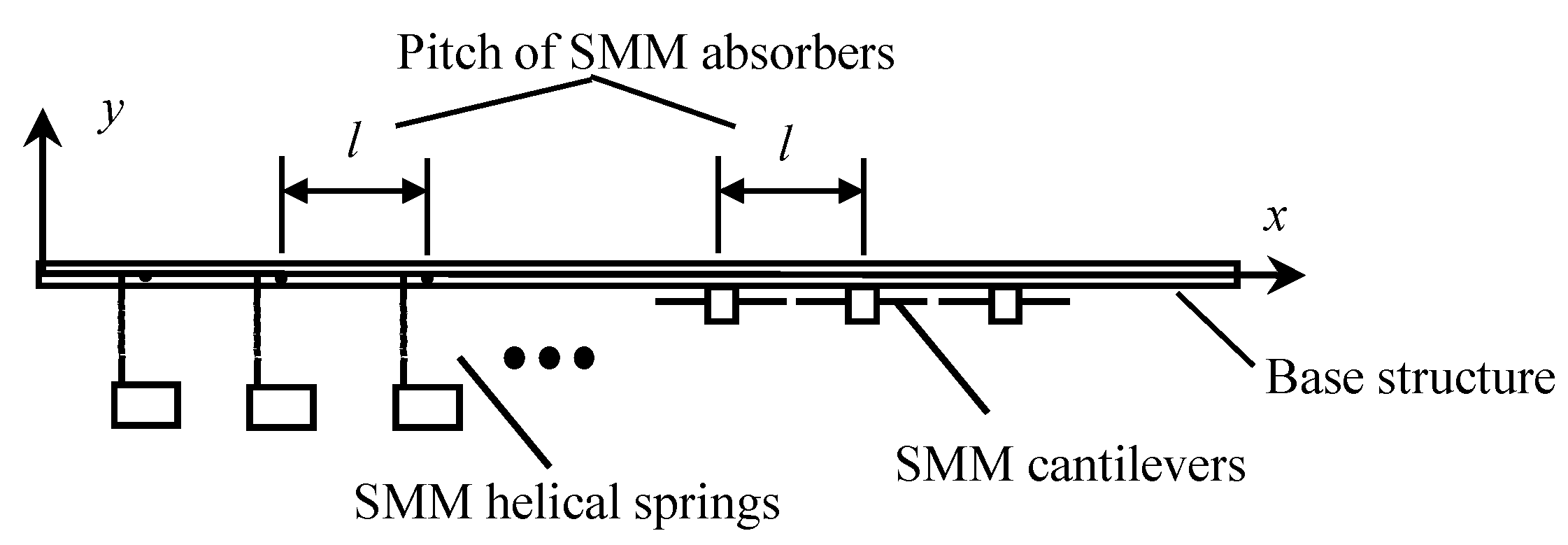
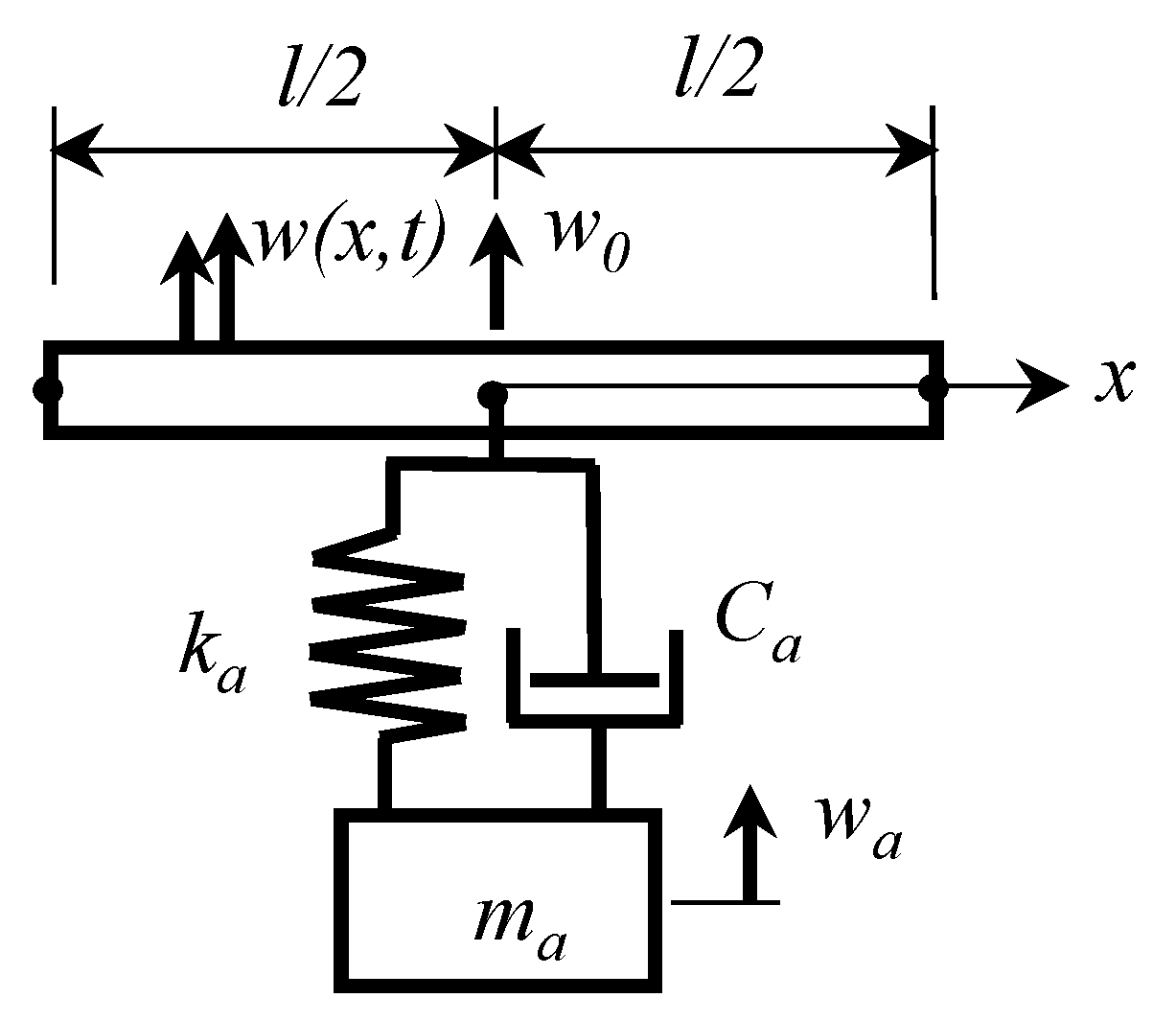
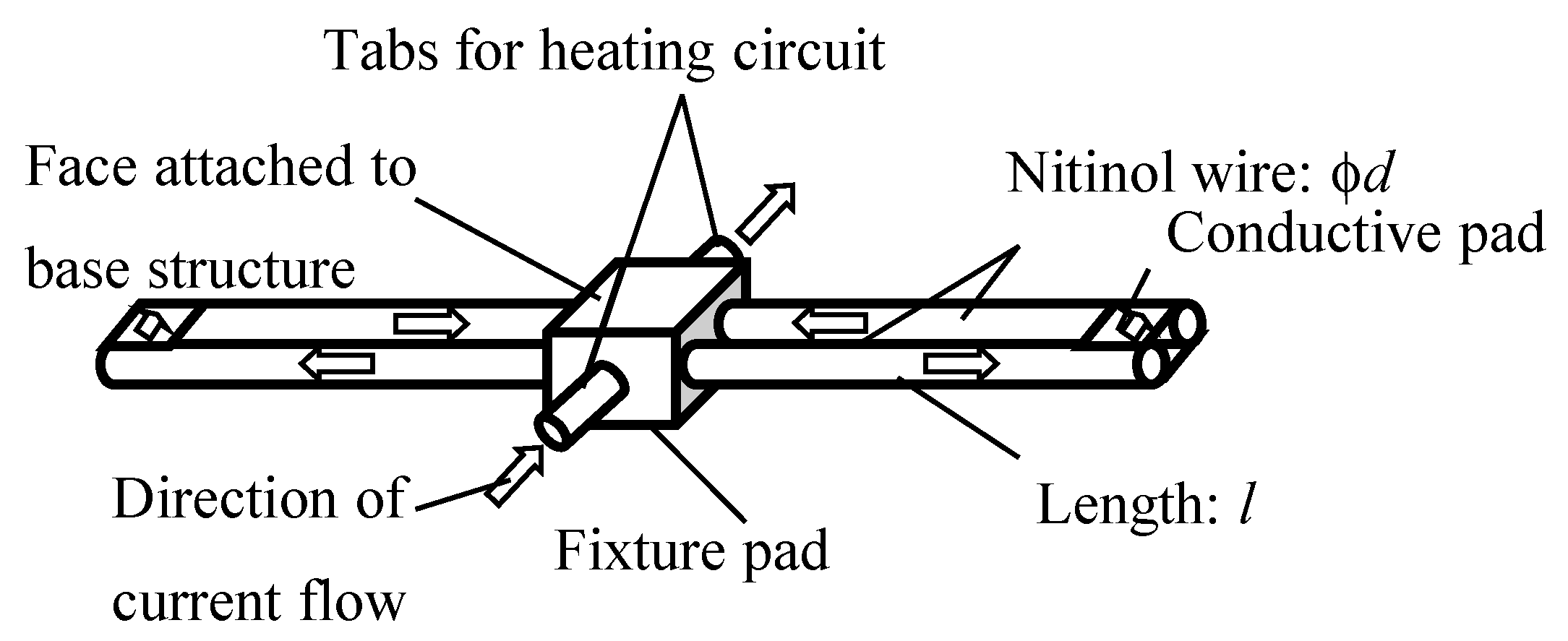


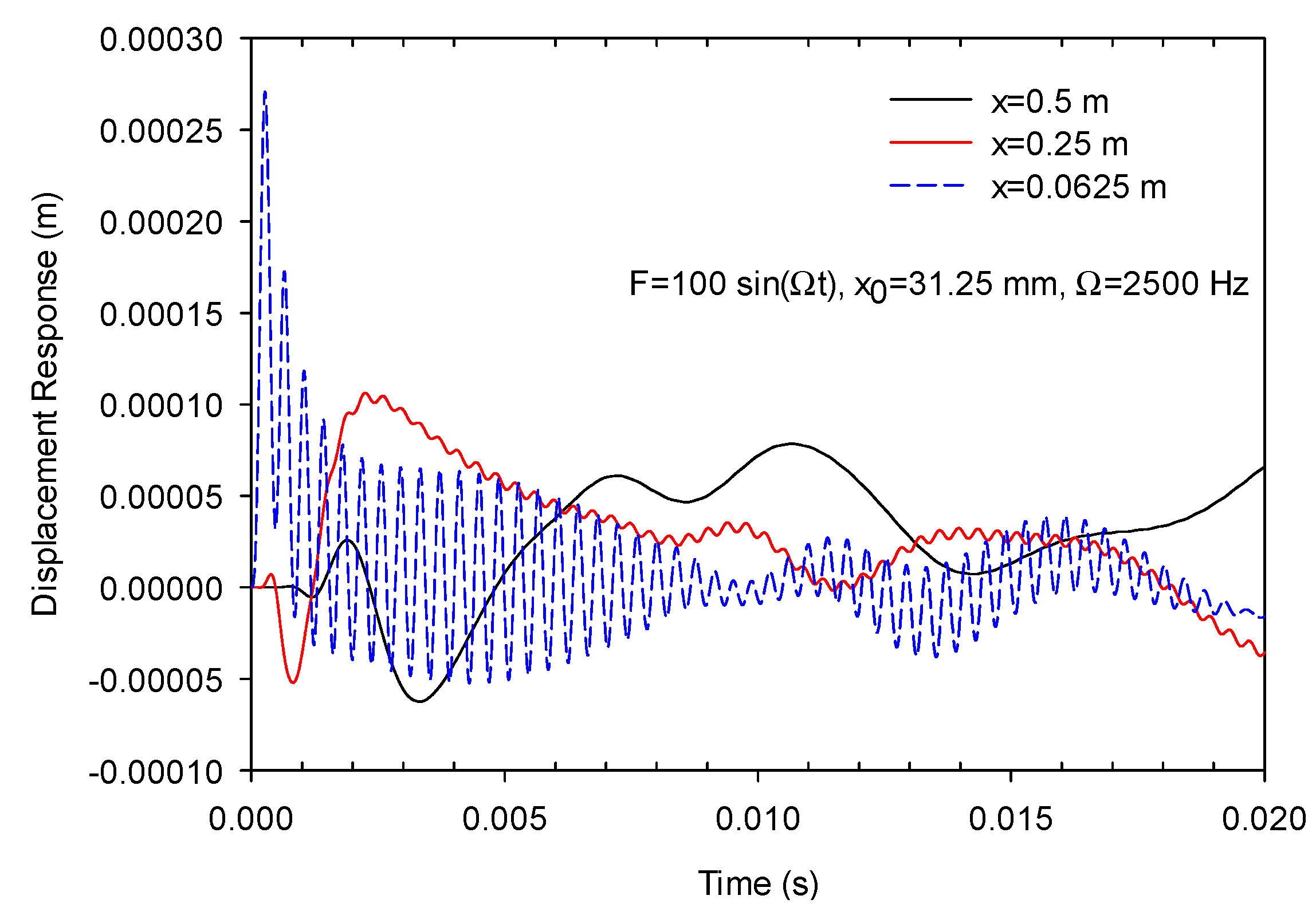
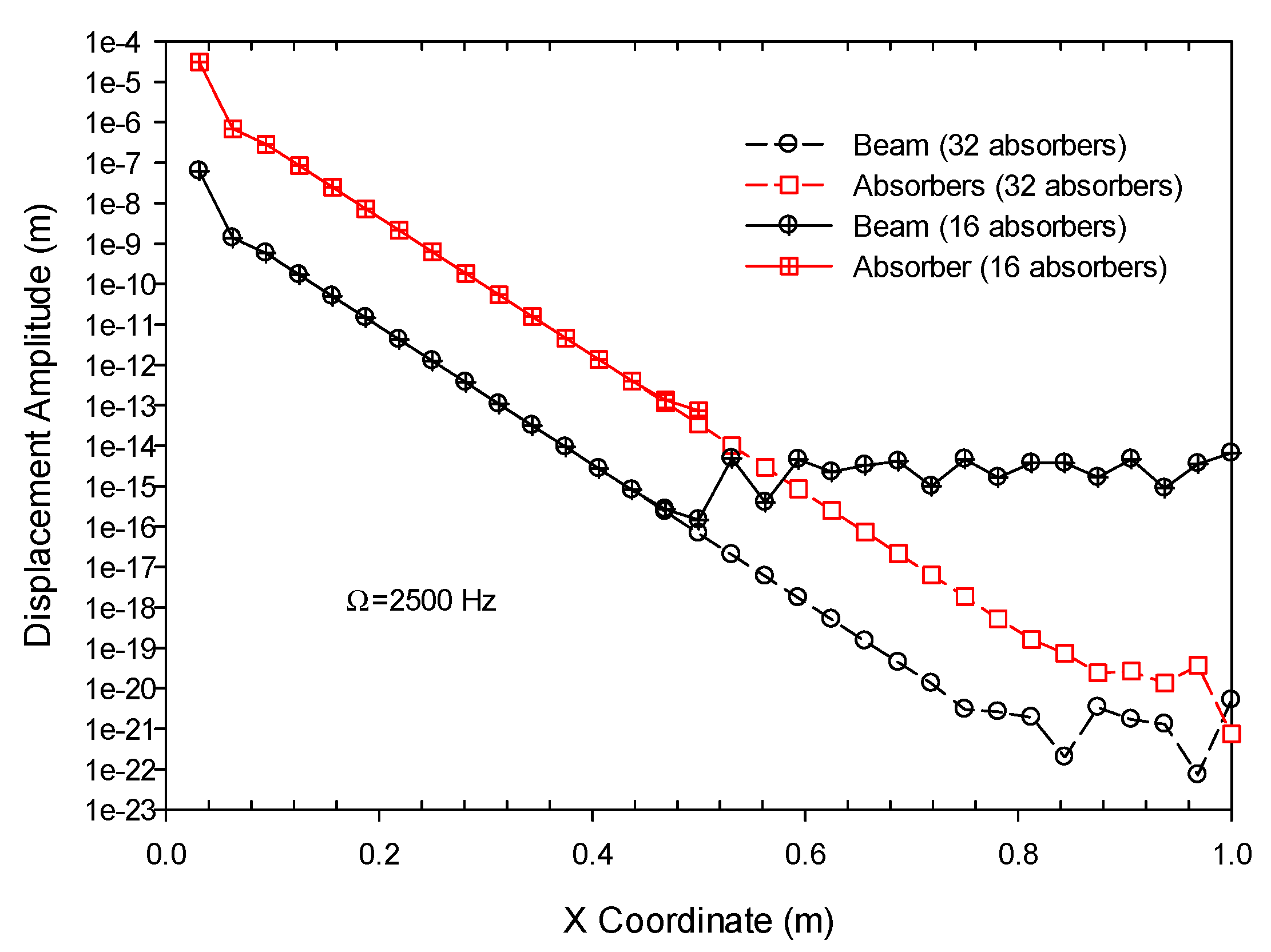
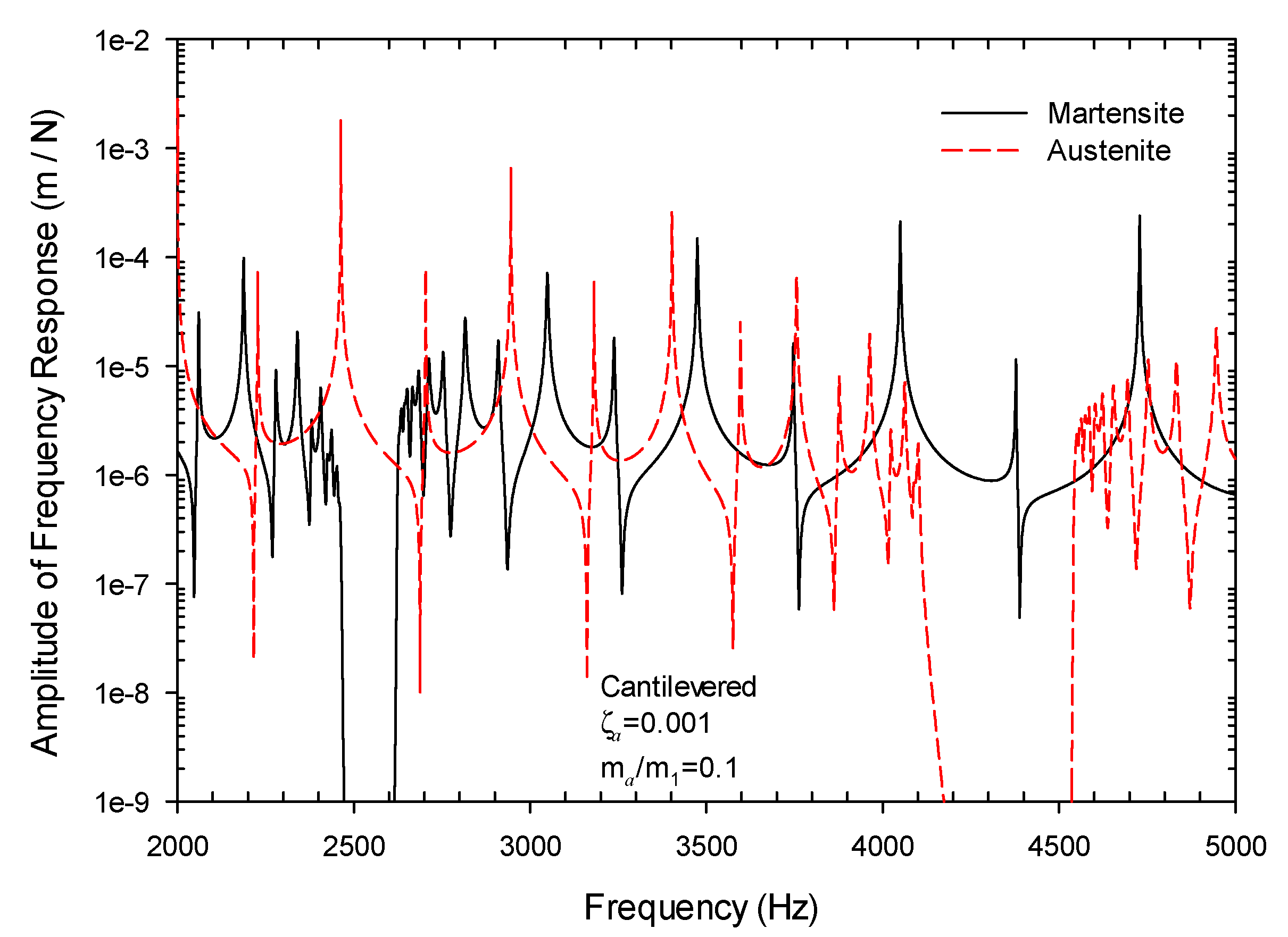

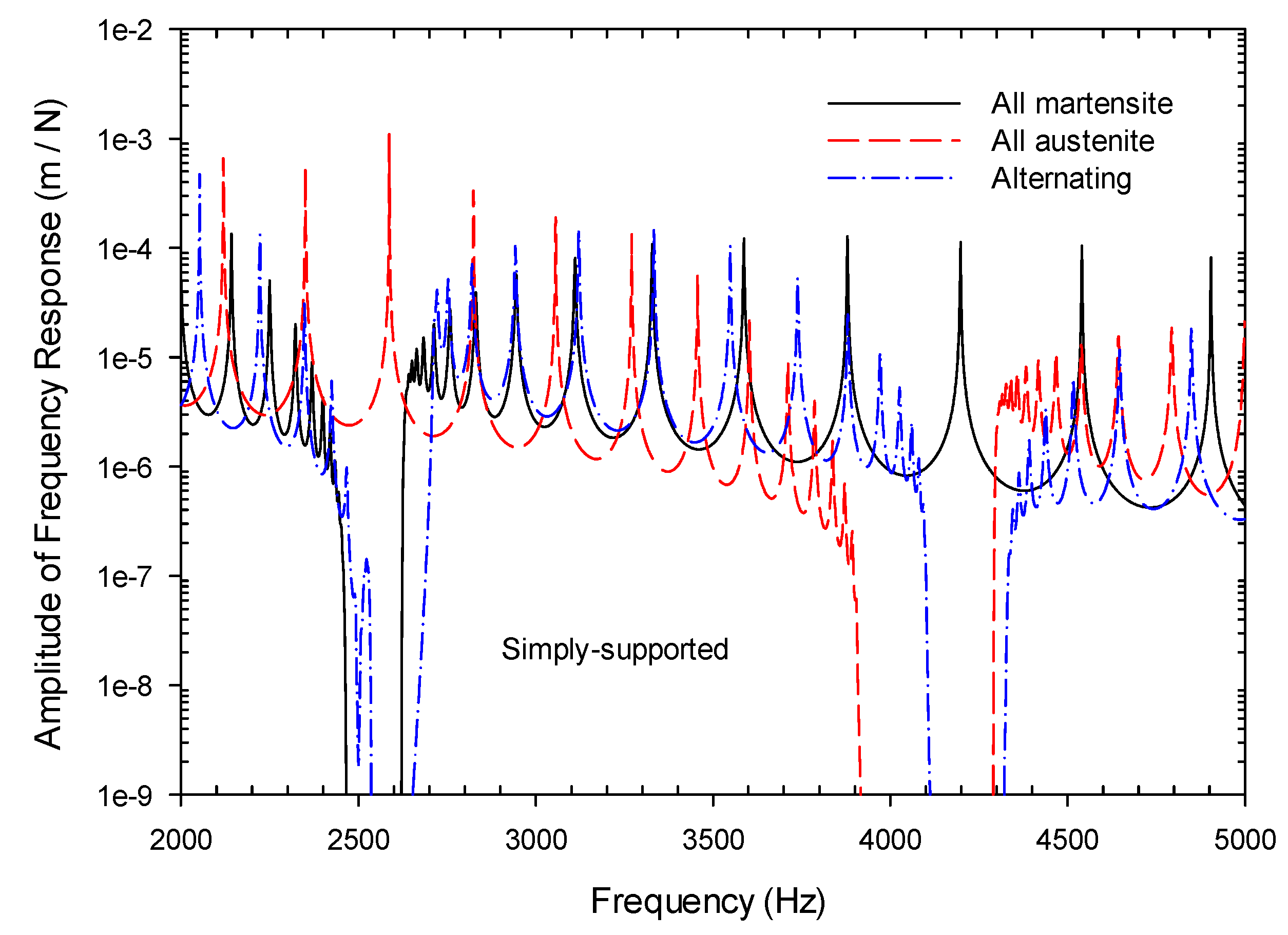
| Beam | No. of Elements | Length | Width | Height | Young’s Modulus, E | Poisson’s Ratio, ν | Mass Density, ρ |
|---|---|---|---|---|---|---|---|
| 32 | 1 m | 5 mm | 3 mm | 72.4 GPa | 0.33 | 2780 kg/m3 | |
| Absorber | ma | ca | ka | ωa | |||
| 1.3031 × 10−4 kg | 0.1 N·s/m | 3.2153 × 104 N/m | 2500 Hz | ||||
| Boundary | Method | Mode 1 | Mode 2 | Mode 3 | Mode 19 | Mode 20 |
|---|---|---|---|---|---|---|
| Cantilever | Theory | 2.476 Hz | 15.76 Hz | 43.40 Hz | - | - |
| FEM | 2.470 Hz | 15.50 Hz | 43.40 Hz | - | - | |
| Error | −0.242% | −1.65% | 0.00% | - | - | |
| Simply-supported | Theory | 6.942 Hz | 27.78 Hz | 62.53 Hz | 2506 Hz | 2777 Hz |
| FEM | 6.942 Hz | 27.77 Hz | 62.48 Hz | 2525 Hz | 2803 Hz | |
| Error | 0.00% | −0.04% | −0.08% | +0.76% | +0.94% | |
| Clamped-clamped | Theory | 15.76 Hz | 43.40 Hz | 85.11 Hz | - | - |
| FEM | 15.74 Hz | 43.38 Hz | 85.04 Hz | - | - | |
| Error | −0.13% | −0.05% | −0.08% | - | - |
© 2018 by the authors. Licensee MDPI, Basel, Switzerland. This article is an open access article distributed under the terms and conditions of the Creative Commons Attribution (CC BY) license (http://creativecommons.org/licenses/by/4.0/).
Share and Cite
Hu, H.-L.; Peng, J.-W.; Lee, C.-Y. Dynamic Simulation of a Metamaterial Beam Consisting of Tunable Shape Memory Material Absorbers. Vibration 2018, 1, 81-92. https://doi.org/10.3390/vibration1010007
Hu H-L, Peng J-W, Lee C-Y. Dynamic Simulation of a Metamaterial Beam Consisting of Tunable Shape Memory Material Absorbers. Vibration. 2018; 1(1):81-92. https://doi.org/10.3390/vibration1010007
Chicago/Turabian StyleHu, Hua-Liang, Ji-Wei Peng, and Chun-Ying Lee. 2018. "Dynamic Simulation of a Metamaterial Beam Consisting of Tunable Shape Memory Material Absorbers" Vibration 1, no. 1: 81-92. https://doi.org/10.3390/vibration1010007





